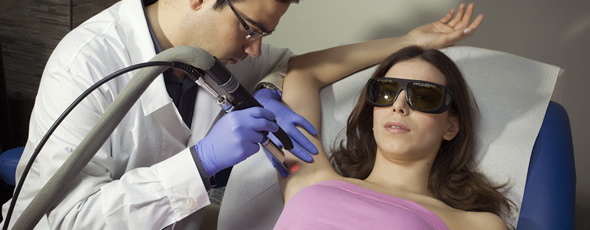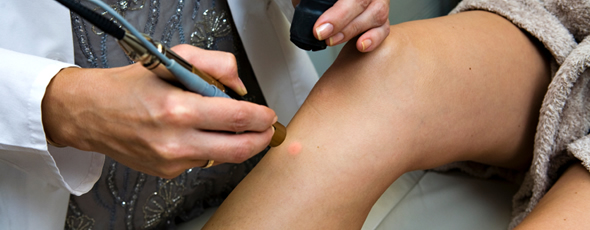To laser είναι ένα μηχάνημα που παράγει φως το οποίο απορροφάται εκλεκτικά από τη μελανίνη του βολβού (ρίζας) της τρίχας
Η αποτρίχωση με laser αποτελεί την πιο αποτελεσματική μέθοδο για τη σταδιακή μόνιμη μείωση έως και εξαφάνιση της τριχοφυΐας. Την προτιμούν τόσο οι γυναίκες όσο και οι άνδρες, κυρίως χάρη στο ότι είναι ασφαλής, γρήγορη και ανώδυνη, ενώ τα αποτελέσματά της είναι πραγματικά εντυπωσιακά.
To laser είναι ένα μηχάνημα που παράγει φως το οποίο απορροφάται εκλεκτικά από τη μελανίνη του βολβού (ρίζας) της τρίχας, με αποτέλεσμα να επιτυγχάνει επιλεκτική εστίαση ενέργειας στην τρίχα η οποία και καταστρέφεται χωρίς να επηρεάζεται η επιδερμίδα (η οποία προστατεύεται μέσω δυναμικής ψύξης). Είναι σημαντικό να διαχωρίζεται η τεχνολογία του laser (και εμείς πιστεύουμε ότι ο Αλεξανδρίτης είναι το αποτελεσματικότερο laser για την αποτρίχωση) από άλλες τεχνολογίες που χρησιμοποιούν φως για αποτρίχωση, όπως είναι το παλμικό φως ή IPL ή φωτόλυση.
Το laser αποτρίχωσης μπορεί να εφαρμοσθεί σε οποιαδήποτε περιοχή του σώματος υπάρχει ανεπιθύμητη τριχοφυΐα όπως:
- Πρόσωπο (άνω χείλος, πηγούνι, παρειές, φαβορίτες, φρύδια κ.α.)
- Χέρια (ολικό ή πήχεις), μασχάλες
- Μπικίνι, πόδια (ολικό / γάμπες ή μηροί μόνο), γλουτοί
- Οσφύς (μέση) και πλάτη (ανδρών – γυναικών)
- Στήθος (ανδρών – γυναικών)
- Γραμμή κοιλιάς κ.α.
Δεν υπάρχει κανένας κίνδυνος για τους ιστούς και τα όργανα που βρίσκονται κάτω από το δέρμα (πχ λεμφαδένες, ωοθήκες κτλ) γιατί το laser έχει συγκεκριμένο βάθος διείσδυσης (το οποίο καθορίζεται από το μήκος κύματος που διαθέτει) και για τον Αλεξανδρίτη δεν φτάνει ούτε μέχρι το υποδόριο λίπος, οπότε είναι απόλυτα ασφαλές.
Η αποτρίχωση με laser γίνεται κυρίως για αισθητικούς λόγους, ωστόσο, υπάρχουν και περιπτώσεις, όπως π.χ. οι γυναίκες που κάνουν υποτροπιάζουσες θυλακίτιδες («σπυράκια με πύον») μετά την αποτρίχωση με κερί ή το ξυράφι. Στις περιπτώσεις αυτές το laser συνιστά την πλέον ενδεδειγμένη ιατρική αντιμετώπιση του προβλήματος.
Ο αριθμός των συνεδριών που θα χρειαστούν εξαρτάται κυρίως από τον φωτότυπο του ασθενούς (το χρώμα του δέρματος σε σχέση με το χρώμα της τρίχας), από τις προηγούμενες μεθόδους αποτρίχωσης που έχουν χρησιμοποιηθεί, από την ηλικία του ασθενούς, και κυρίως από την πιθανή συνύπαρξη κάποιου ενδοκρινικού-ορμονικού προβλήματος. Οπότε δεν μπορούμε να προβλέψουμε με απόλυτη ακρίβεια πόσες συνεδρίες θα χρειαστεί κάθε ασθενής, αλλά σε γενικές γραμμές μπορούμε να συζητάμε κατά μέσο όρο για 5 συνεδρίες (με άλλες τόσες επαναληπτικές συνεδρίες οι οποίες γίνονται σε 15-20 ημέρες και οι οποίες γίνονται δωρεάν).
[blockquote]Για τη θεραπεία με laser, προηγείται ένα δωρεάν ραντεβού για την λήψη ιστορικού (μπορεί να απαιτείται και ορμονικός έλεγχος πριν την αρχή της θεραπείας) ,αξιολόγηση της τριχοφυΐας και την ενημέρωση και επίλυση κάθε απορίας σχετικά με την αποτρίχωση με laser.[/blockquote]

«Η αποτρίχωση με laser αποτελεί τον πιο ασφαλή και τον πιο αποτελεσματικό τρόπο για μόνιμη απομάκρυνση της ανεπιθύμητης τριχοφυΐας. Δεν πρέπει να συγχέουμε το laser μα άλλες μεθόδους όπως είναι η φωτοαποτρίχωση, το παλμικό φως, δηλαδή το IPL, γιατί το laser είναι αποκλειστικά σχεδιασμένο για κάνει αυτή τη δουλειά και την κάνει πάρα πολύ καλά. Απαιτούνται 5 συνεδρίες και τα επαναληπτικά τους για να απομακρύνουμε την ανεπιθύμητη τριχοφυΐα από την εκάστοτε περιοχή. Προτείνουμε το laser Αλεξανδρίτη ως καλύτερο για αυτή τη θεραπεία και συγκεκριμένα το LPX του αμερικάνικου κολοσσού LightAge. Είναι η εταιρεία που έχει ανακαλύψει τον Αλεξανδρίτη και έχει τα καλύτερα αποτελέσματα στους μικρότερους χρόνους. Συγκεκριμένα, μπορούμε να κάνουμε αποτρίχωσε σε ολόκληρο το πόδι μόλις 20 λεπτά, το ίδιο και για μια αντρική πλάτη και αυτό είναι πολύ σημαντικό για τον ασθενή ο οποίος σέβεται το χρόνο του. Δεν υπάρχει καμία αντένδειξη, ο κόσμος δεν πρέπει να ανησυχεί, γιατί το laser δεν φτάνει κάτω από τα 2/3 του δέρματος οπότε δεν μπορεί να βλάψει τα εσωτερικά όργανα ή τους λεμφαδένες και είναι απόλυτα ασφαλές να γίνει σε οποιαδήποτε ηλικία.»
Ποιοι είναι κατάλληλοι για αποτρίχωση με laser;
Τόσο οι γυναίκες όσο και οι άντρες επιζητούν την αποτρίχωση με laser για να απομακρύνουν την ανεπιθύμητη τριχοφυΐα. Η εφαρμογή μπορεί να γίνει στο πρόσωπο, στις μασχάλες, στο μπικίνι, στους γλουτούς, στα πόδια, στην κοιλιά, στην μέση, στην πλάτη. Το laser στοχεύει την χρωστική του δέρματος (μελανίνη) οπότε ο ιδανικός συνδυασμός για την αποτρίχωση είναι ένα άτομο με ανοικτό χρώμα δέρματος και σκούρο χρώμα τρίχας
Πώς λειτουργεί η αποτρίχωση με laser; Τι ρόλο παίζει το χρώμα της τρίχας;
Το laser στοχεύει την χρωστική του δέρματος (μελανίνη) οπότε οι θεραπείες έχουν την μέγιστη αποτελεσματικότητα σε σκουρόχρωμες και χοντρές τρίχες οι οποίες περιέχουν μεγάλη ποσότητα χρωστικής. Οι λεπτές τρίχες και το χνούδι απορροφούν δυσκολότερα την θερμότητα που παράγει το laser. Επίσης, οι ξανθές τρίχες που περιέχουν λιγότερη χρωστική, θα χρειαστούν περισσότερες θεραπευτικές συνεδρίες για να εξασφαλίσουμε ένα μόνιμο αποτέλεσμα αποτρίχωσης. Τέλος, σε μεγαλύτερες ηλικίες όπου οι τρίχες έχουν χάσει τελείως το χρώμα τους (γκρί ή λευκές) δεν είναι δυνατόν να αντιμετωπιστούν με τη βοήθεια του laser.
Υπάρχει διαφορά μεταξύ των τεχνολογιών IPL (φωτόλυση) και LASER στην αποτρίχωση;
Πρόκειται για δυο τελείως διαφορετικές τεχνολογίες. Το IPL (φωτόλυση) παράγει ένα ευρύ φάσμα φωτός το οποίο θερμαίνει και τους περιβάλλοντες ιστούς οπότε το αποτέλεσμα όσον αφορά την αποτρίχωση είναι φτωχότερο, ενώ ο ασθενής (ειδικά αν διαθέτει σκούρο δέρμα) διατρέχει μεγαλύτερο κίνδυνο για να υποστεί έγκαυμα από την εφαρμογή. Οι συσκευές IPL είναι φθηνότερες από τα αντίστοιχα laser, ενώ δεν απαιτείται ιατρός για να κάνει την εφαρμογή και για αυτό έχουν βρει μεγάλη διάδοση στα διάφορα ινστιτούτα αισθητικής. Συμπερασματικά τα εξειδικευμένα laser για αποτρίχωση (Αλεξανδρίτης, Διοδικά, NdYag) πετυχαίνουν καλύτερα και ταχύτερα αποτελέσματα σε σχέση με την φωτόλυση.
Πόσες συνεδρίες με laser θα χρειαστώ και ποιο είναι το χρονικό διάστημα που θα απέχουν μεταξύ τους οι συνεδρίες;
Οι περισσότεροι ασθενείς χρειάζονται το λιγότερο 5-6 συνεδρίες οι οποίες απέχουν μεταξύ τους 4 εβδομάδες περίπου. Κάθε συνεδρία συνοδεύεται από μια επαναληπτική συνεδρία η οποία γίνεται μετά από 15-20 ημέρες από την αρχική συνεδρία και την οποία συμπληρώνει και τελειοποιεί. Ο ακριβής αριθμός των συνεδριών που θα χρειαστούν εξαρτάται από την αντίθεση μεταξύ του χρώματος δέρματος του ασθενούς και του χρώματος της τρίχας του. Όσο πιο ανοικτό είναι το δέρμα και όσο πιο σκούρες οι τρίχες, τόσο λιγότερες συνεδρίες θα χρειαστούν.
Είναι επώδυνη η εφαρμογή laser αποτρίχωσης;
Όχι. Η εφαρμογή γίνεται με ταυτόχρονη πολύ ισχυρή ψύξη της περιοχής (με κρύο αέρα). Η ψύξη αυτή εγγυάται ασφάλεια για την θεραπεία και ανώδυνη θεραπεία. Μόνο ένα μικρό ποσοστό ασθενών καταφεύγουν στην χρήση αναισθητικής κρέμας (EMLA) μόνο για την περιοχή του βικινι η οποία θεωρείται και η πιο ευαίσθητη στον πόνο.
Τι πιθανές ανεπιθύμητες ενέργειες έχει η εφαρμογή laser αποτρίχωσης;
Η μόνη ανεπιθύμητη ενέργεια που παρατηρείται είναι μια μικρή ερυθρότητα και ο σχηματισμός μικρών πομφών (εξογκωματάκια του δέρματος εκεί ακριβώς που είναι τα στόμια των τριχικών θυλάκων στο δέρμα) οι οποίοι μπορεί να είναι ήπια κνησμώδεις. Αυτά είναι πλήρως αναστρέψιμα και διαρκούν για λίγες ώρες μόνο μετά την θεραπεία. Ουσιαστικά δεν πρόκειται για ανεπιθύμητη ενέργεια αλλά για το αποτέλεσμα της «έκρηξης» του βολβού (ρίζα) της τρίχας , με την επίδραση του laser, μέσα στο δέρμα (σημαίνει δηλαδή ότι πετύχαμε αποτελεσματική αποτρίχωση!). Αντιμετωπίζονται εύκολα με την εφαρμογή στο δέρμα μιας ενυδατικής αντιφλεγμονώδους κρέμας μετά την εφαρμογή.
Πώς μπορώ να πετύχω με την βοήθεια του laser την ελάττωση (αλλά όχι την εξαφάνιση) της πυκνότητας της τριχοφυίας μιας περιοχής;
Αυτό μπορεί να επιτευχθεί, αν διακόψουμε την θεραπεία με laser στις 3 εφαρμογές (και ισάριθμες επαναληπτικές συνεδρίες) αντί για 5-6 συνεδρίες οι οποίες απαιτούνται για την πλήρη εξαφάνιση των τριχών.
Τι προετοιμασία πρέπει να κάνω πριν την εφαρμογή του laser για αποτρίχωση;
Δεν πρέπει να προηγείται καμία αποτριχωτική μέθοδος η οποία ξεριζώνει την τρίχα για χρονικό διάστημα ενός μηνός πρίν την εφαρμογή του laser. Αυτό γιατί αν χρησιμοποιηθεί κερί ή silkepil πριν την εφαρμογή του laser , αυτά ξεριζώνουν την τρίχα μαζί με την ρίζα της, οπότε το laser δεν θα μπορέσει να στοχεύσει την ρίζα της τρίχας και να επιτύχει αποτελεσματική καταστροφή της. Για τον ίδιο λόγο δεν επιτρέπεται η χρήση κεριού καθ όλη την διάρκεια που κάνουμε αποτρίχωση με laser (στο ενδιάμεσο των εφαρμογών μπορούμε να χρησιμοποιούμε ξυράφι αν αυτό είναι απαραίτητο).
Επίσης η περιοχή που πρόκειται να αποτριχωθεί πρέπει να έχει ξυριστεί (ή να κοπούν με ψαλιδάκι οι τρίχες στο πρόσωπο) 2-3 μέρες πριν την εφαρμογή του laser. Αυτό μας εξασφαλίζει ότι η ενέργεια του laser θα αξιοποιηθεί εκεί ακριβώς που πρέπει (δηλαδή στη ρίζα της τρίχας) και όχι στο στέλεχος της τρίχας (το τμήμα της τρίχας που εξέχει επάνω από το δέρμα). Επίσης αν το laser “χτυπήσει» το στέλεχος της τρίχας, αυτό θα λιώσει και θα δημιουργήσει μια γραμμούλα-έγκαυμα πάνω στην επιφάνεια του δέρματος, πράγμα το οποίο επίσης δεν είναι επιθυμητό.
Ως συμπέρασμα πρέπει να ξυρίζουμε την περιοχή 2-3 μέρες πριν την κάθε εφαρμογή, και να αποφεύγουμε για όλη την διάρκεια της θεραπείας με laser μεθόδους αποτρίχωσης που ξεριζώνουν την τρίχα.
Ποιοι είναι οι λόγοι υπερβολικής τριχοφυΐας (υπερτρίχωσης-δασυτριχισμού) που πρέπει να διερευνηθούν πριν την έναρξη θεραπείας με laser?
Η υπερβολική τριχοφυϊα μπορεί να οφείλεται σε κληρονομικότητα, ενδοκρινολογικές (ορμονικές) διαταραχές όπως το σύνδρομο πολυκυστικών ωοθηκών και η αντίσταση στην ινσουλίνη, προβλήματα του θυρεοειδή. Όμως μπορεί να οφείλεται και σε συγκεκριμένες φαρμακευτικές αγωγές που έχουμε ξεκινήσει, στη φυσιολογική διαδικασία της γήρανσης καθώς και υπερβολική χρήση αποτριχωτικών μεθόδων οι οποίες επηρεάζουν την ρίζα της τρίχας.
Συνήθως πριν ξεκινήσουμε την θεραπεία με laser κάνουμε μια διερεύνηση (εργαστηριακό έλεγχο με εξετάσεις αίματος, γυναικολογικό υπερηχογράφημμα) για τις παθολογικές αιτίες υπερτρίχωσης ειδικά όταν υπάρχει υπερβολική τριχοφυϊα ή όταν υπάρχει τριχοφυϊα σε περιοχές που δεν θα έπρεπε να υπάρχει (στην περιοχή της γνάθου-πηγούνι στις γυναίκες ή κάτω από τον ομφαλό στις γυναίκες κτλ)
[gravityform id=”4″ name=”Περισσότερες Πληροφορίες” title=”false” ajax=”true”][/tab]


